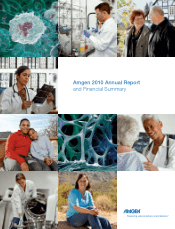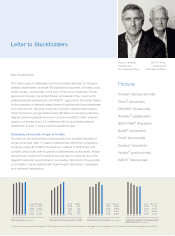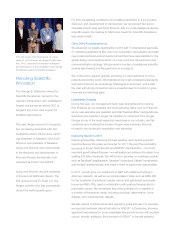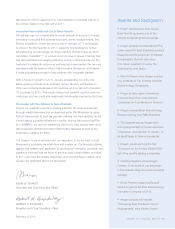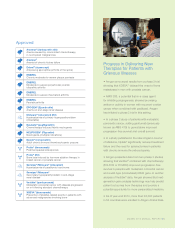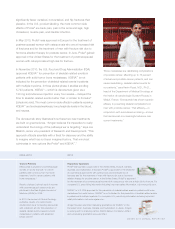Amgen 2010 Annual Report Download - page 9
Download and view the complete annual report
Please find page 9 of the 2010 Amgen annual report below. You can navigate through the pages in the report by either clicking on the pages listed below, or by using the keyword search tool below to find specific information within the annual report.
20102003-2010
Trials in Patients
Denosumab is studied in postmenopausal
women at risk for fracture,4 in cancer
patients with bone loss from hormone
treatment,5 and in cancer patients with
bone metastases.6
Results of phase 3 pivotal study in women
with postmenopausal osteoporosis are
published in the New England Journal of
Medicine (NEJM) in 2009.7
In 2010, the Journal of Clinical Oncology
publishes results of a randomized,
double-blind study comparing denosumab
with zoledronic acid for the prevention of
skeletal-related events caused by bone
metastases in patients with advanced
breast cancer.8
Regulatory Approvals
Prolia® (denosumab) is approved in the United States, Europe, Canada,
Australia, and Switzerland. In Europe, Prolia® is approved for the treatment
of postmenopausal women with osteoporosis and increased risk of
fractures and for the treatment of men with fracture risk due to hormone
ablation therapy for prostate cancer. In the United States, Prolia® is approved
for the treatment of postmenopausal women with osteoporosis who are at high risk for fracture. For
complete U.S. prescribing information including important safety information, visit www.prolia.com.
XGEVA™ is U.S. FDA approved for the prevention of skeletal-related events in patients with bone
metastases from solid tumors. XGEVA™ is not indicated for the prevention of skeletal-related events
in patients with multiple myeloma. For complete U.S. prescribing information including important
safety information, visit www.xgeva.com.
Amgen has also submitted marketing applications for XGEVA™ in the
European Union, Australia, Canada, and Switzerland. In Japan, Amgen
is working with its licensing partner, Daiichi-Sankyo Company, Limited,
and a marketing application was submitted.
“Bone metastases are debilitating complications
of prostate cancer, affecting up to 75 percent
of advanced-prostate-cancer patients, and can
cause devastating, skeletal-related events for
our patients,” says Karim Fizazi, M.D., Ph.D.,
head of the Department of Medical Oncology at
the Institut de cancérologie Gustave Roussy in
Villejuif, France. “Denosumab has shown superior
effi cacy in preventing skeletal complications in
men with prostate cancer. That effi cacy—in
conjunction with subcutaneous dosing—shows
that denosumab is a meaningful advance over
current treatments.”
signifi cantly fewer vertebral, nonvertebral, and hip fractures than
placebo. In the U.S. product labeling, the most common side
effects of Prolia® are back pain, pain in the arms and legs, high
cholesterol, muscle pain, and bladder infection.
In May 2010, Prolia® was approved in Europe for the treatment of
postmenopausal women with osteoporosis who are at increased risk
of fractures and for the treatment of men with fracture risk due to
hormone ablation therapy for prostate cancer. In June, Prolia® gained
approval in the United States for the treatment of postmenopausal
women with osteoporosis at high risk for fracture.
In November 2010, the U.S. Food and Drug Administration (FDA)
approved XGEVA™ for prevention of skeletal-related events in
patients with solid-tumor bone metastases. XGEVA™ is not
indicated for the prevention of skeletal-related events in patients
with multiple myeloma. In three pivotal phase 3 studies enrolling
5,723 patients, XGEVA™—which is denosumab given as a
120 mg subcutaneous injection every four weeks—delayed the
time to skeletal-related events better than or similar to Zometa®
(zoledronic acid). The most common side effects in patients receiving
XGEVA™ are tiredness/weakness, low phosphate levels in the blood,
and nausea.
The denosumab story illustrates how these two new treatments
are built on great science. “Amgen believes it’s imperative to really
understand the biology of the pathways we’re targeting,” says Joe
Miletich, senior vice president of Research and Development. “This
approach attracts scientists with a thirst for discovery and the ability
to imagine what has not been imagined before. That mind-set
culminates in new options like Prolia® and XGEVA™.”
AMGEN 2010 ANNUAL REPORT ■ 7

